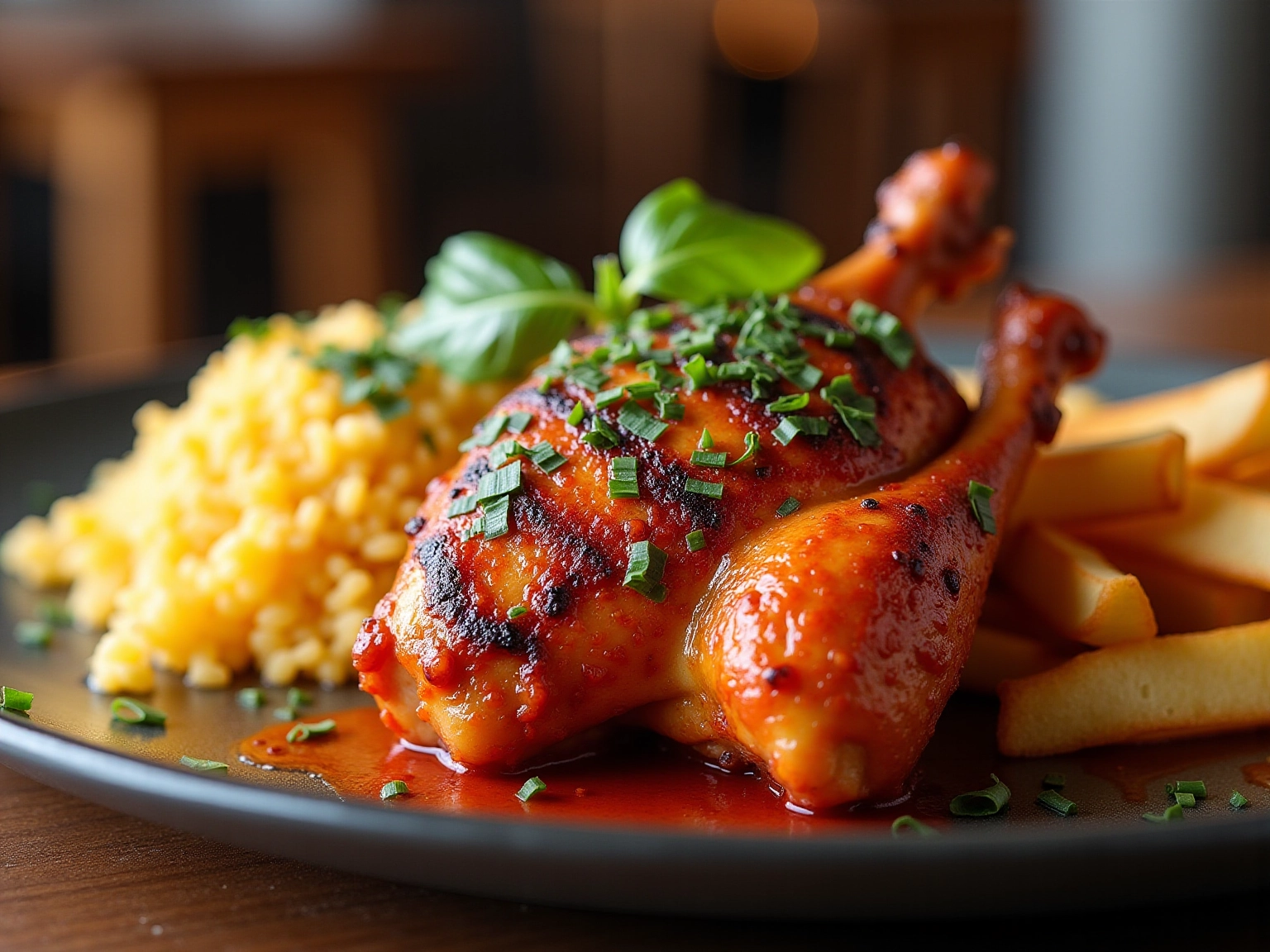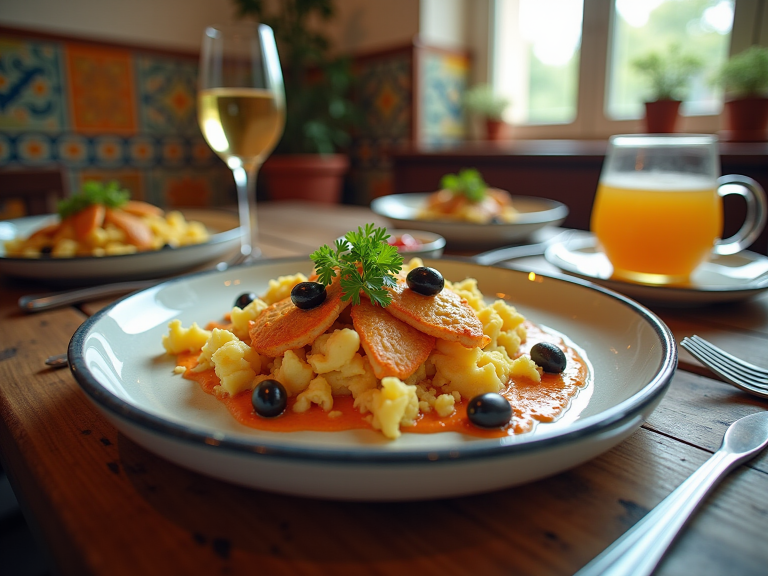Overview
This article highlights ten must-try food dishes in Portugal, showcasing their cultural significance and popularity among both locals and tourists. Each dish, like Bacalhau à Brás and Pastéis de Nata, tells a story of Portugal’s rich culinary heritage. With detailed descriptions and insights into their historical and regional importance, these dishes are essential experiences for anyone visiting the country. You’re in for a treat as you explore the vibrant flavors and traditions that make Portuguese cuisine so special!
Key Highlights:
- Bacalhau à Brás is a classic dish featuring salted cod, onions, garlic, crispy potatoes, and scrambled eggs, popular in Lisbon and Porto.
- The tradition of bacalhau includes over 365 recipes, showcasing the versatility of cod in Portuguese cuisine.
- Francesinha is a hearty sandwich from Porto, layered with cured meats and topped with melted cheese and a rich tomato-beer sauce, known as a hangover remedy.
- Pastéis de Nata are famous custard tarts from the Jerónimos Monastery, celebrated for their creamy filling and flaky crust, with over 1,500 bakeries in Lisbon selling them.
- Cataplana de marisco is a seafood stew cooked in a clam-shaped pot, highlighting fresh local seafood and traditional cooking methods in the Algarve region.
- Piri-Piri chicken is marinated with spicy peppers and grilled, reflecting Portugal’s culinary history and colonial influences.
- Porco preto, or black pig, is prized for its unique flavor, contributing to traditional dishes and local economies in the Alentejo region.
- Caldo Verde is a comforting soup made with pureed potatoes, kale, and chorizo, symbolizing Portuguese hospitality and family traditions.
- Bifana is a marinated pork sandwich, popular among locals and tourists, often found at street vendors in Lisbon.
- Petiscos are shareable small plates that promote communal dining, featuring a variety of flavors and ingredients, central to Portuguese food culture.
- Arroz doce is a traditional rice pudding that embodies comfort and nostalgia, often served at festive occasions and family gatherings.
Introduction
Portugal’s culinary landscape is a vibrant tapestry woven from centuries of tradition, innovation, and cultural exchange. Among its most cherished offerings are a variety of dishes that not only tantalize your taste buds but also tell stories of the country’s rich heritage. From the comforting warmth of Caldo Verde, a beloved green soup, to the indulgent layers of Francesinha, a hearty sandwich that has become a staple in Porto, each dish reflects the unique flavors and history of the region.
And let’s not forget the sweet treats! The iconic Pastéis de Nata and the nostalgic Arroz Doce showcase the artistry of Portuguese desserts. Meanwhile, savory delights like Piri-Piri Chicken and Bifana capture the spirit of street food culture. This exploration of Portuguese cuisine invites you to savor the essence of Portugal through its most famous dishes, each a celebration of flavor, tradition, and community. So, are you ready to dive into this delicious adventure?
Bacalhau à Brás: A Classic Cod Dish
Bacalhau à Brás is considered one of the best Portugal food dishes that truly showcases the versatility of salted cod! Imagine a delightful mix of onions, garlic, crispy thin potatoes, and shredded bacalhau, all brought together with creamy scrambled eggs. Often topped with black olives and fresh parsley, this dish is as visually appealing as it is delicious.
Did you know that the Portuguese tradition of bacalhau boasts over 365 distinct recipes—one for each day of the year? Bacalhau à Brás is especially popular in traditional eateries across the country, particularly in vibrant food hubs like Lisbon and Porto, where it is often regarded as one of the best Portugal food options and has become a staple on countless menus.
This dish not only reflects the best Portugal food and its rich culinary heritage but also highlights the enduring love for cod, a fish that has been a key player in the country’s gastronomy for centuries.
And if you’re curious, Bacalhau à Lagareiro is another frequently prepared recipe featuring salted cod, showcasing the wonderful variety of ways this beloved ingredient is celebrated in Portuguese cuisine.
So, are you ready to dive into these flavors?
Francesinha: The Hearty Porto Sandwich
Francesinha, or ‘little Frenchie,’ is a beloved sandwich from Porto and is often regarded as one of the best Portugal food that you absolutely have to try! It’s known for its indulgent layers of cured meats, like linguiça (smoked sausage), fresh sausage, and steak, all nestled between soft bread. Topped with a generous layer of melted cheese and smothered in a rich tomato and beer sauce, this hearty creation is often served with a side of crispy fries. It’s no wonder this sandwich has earned a reputation as a hangover remedy, solidifying its status as a staple in Porto’s vibrant nightlife. Locals and visitors alike seek out its comforting embrace after a night out.
You’ll be pleased to know that the Francesinha’s popularity is underscored by its average price of around €10, making it an accessible indulgence for many. Food experts in Porto rave about its unique flavor profile and satisfying nature. One local chef even mentioned that ‘the combination of flavors in a Francesinha is unmatched, making it a must-try for anyone visiting the city.’ This sandwich does more than just satisfy hunger; it acts as a cultural symbol, reflecting the city’s rich food heritage.
A great spot to enjoy a Francesinha is A Sandeira do Porto, a rustic sandwich shop celebrated for its affordable yet tasty offerings. Here, you can savor a Francesinha for about €7, and don’t miss out on their ham, brie, and mango sandwich, which also receives high praise for its innovative flavor combinations. These eateries contribute to the rich tapestry of Porto’s sandwich culture, where the Francesinha truly reigns supreme.
The Francesinha’s history is fascinating, rooted in the city’s diverse influences. It has evolved from a simple dish into a food icon that attracts both locals and tourists. Statistics reveal that the Francesinha is not just a local favorite; it has become a culinary icon, with many tourists seeking it out as a quintessential Porto experience. This lasting popularity guarantees that the Francesinha remains a cherished option for anyone discovering the tastes of the region.

Pastéis de Nata: The Famous Custard Tart
Pastéis de Nata are truly a treat! These exquisite, creamy custard tarts are nestled in a flaky pastry crust and often finished with a delightful dusting of cinnamon and powdered sugar. They trace their origins back to the Jerónimos Monastery in Belém, where monks first crafted them in the 19th century. Today, these pastries represent the best Portugal food, celebrated for their rich flavor and delicate texture.
You’ll want to enjoy Pastéis de Nata warm and fresh from the oven! You can find them in countless bakeries across the country, with the renowned Pastéis de Belém being the most famous. In Lisbon alone, there are over 1,500 bakeries selling these iconic tarts. Their immense popularity showcases the variety of interpretations of this classic recipe.
The popularity of Pastéis de Nata has turned them into a food staple and a significant attraction for tourists. Have you heard of the annual Concurso do Melhor Pastel de Nata? It showcases the best of these pastries and fuels their fame even more! As David Leite, a celebrated author and cooking teacher, emphasizes, “The experience of tasting Pastéis de Nata is deeply enriched by understanding their history and the artistry involved in their creation.”
Case studies reveal that the first Fábrica de Pastéis de Belém continues to thrive, proving the enduring appeal of these custard tarts. When you visit, I encourage you to savor them in traditional settings, which enhances the tasting experience and connects you to the local culture. For instance, the case study titled “How to Best Enjoy Pastéis de Belém” offers valuable tips on appreciating these pastries, highlighting the importance of freshness and the ideal setting for consumption. With their deep-rooted history and irresistible flavor, Pastéis de Nata are considered some of the best Portugal food that anyone exploring the culinary landscape of Portugal must try!

Cataplana de Marisco: A Seafood Stew Delight
Cataplana de marisco is a delightful seafood stew, traditionally cooked in a unique clam-shaped copper pot called a cataplana. Imagine a vibrant mix of fresh seafood—think clams, shrimp, and fish—simmered together with ripe tomatoes, onions, and a blend of aromatic spices. What’s truly special about the cataplana cooking technique is how it allows the ingredients to steam together, enhancing their flavors and creating a harmonious meal that celebrates the coastal bounty of the Algarve region!
In the Algarve, where seafood reigns supreme, Cataplana de marisco is one of the best Portugal food dishes. The local food scene is bursting with seafood options, yet this stew is often hailed as the best Portugal food that anyone visiting must try. Expert chefs always stress the importance of using fresh, local ingredients to achieve the best flavor. For example, the inclusion of Lingueirão, a razor clam species currently facing decline, underscores the need for sustainable seafood practices in traditional cooking. As Fin Christoforidis beautifully puts it, “The essence of Cataplana de marisco lies in its fresh ingredients and the care taken in its preparation.”
Did you know that seafood consumption in the Algarve is quite significant? Approximately 70% of the local population enjoys seafood at least once a week! Dishes like Cataplana de marisco not only boost the local economy but also enrich the region’s culinary traditions. A fascinating case study from Taste Porto shows how guided food tours in the area highlight this iconic dish, teaching participants about its preparation and cultural significance. The Guardian even recognized these experiences as some of the finest food tours worldwide, exploring the hidden culinary gems of Porto and deepening appreciation for traditional cuisine, especially Cataplana de marisco.
Overall, Cataplana de marisco is considered one of the best Portugal food dishes; it’s more than just a meal; it’s a celebration of the Algarve’s rich maritime culture and a testament to the artistry of cooking in Portugal. So, next time you find yourself in this beautiful region, make sure to indulge in this incredible dish—you won’t regret it!
Piri-Piri Chicken: A Spicy Grilled Favorite
Piri-Piri chicken is such a vibrant dish that truly showcases the best Portugal food and highlights the rich flavors of Portuguese cuisine! Marinated in a zesty blend of piri-piri peppers, garlic, and lemon juice, this chicken is grilled to perfection, resulting in a tantalizing combination of heat and flavor. Did you know the roots of the piri-piri pepper can be traced back to Africa? It’s fascinating how it highlights the colonial past and the food exchanges that shaped it.
As Anthony Bourdain once noted, Portugal’s character is deeply imprinted by its coastline and history with the sea, which resonates beautifully in its culinary traditions. You’ll often find Piri-Piri chicken accompanied by rice or fries, making it a cherished favorite among both locals and tourists. It really embodies the adventurous spirit of dining in Portugal!
Statistics show that piri-piri peppers are becoming increasingly favored in Portuguese cuisine, emphasizing their importance in modern cooking. Travelers are encouraged to embrace bold flavors, and this dish stands out as a must-try among the best Portugal food, providing a delicious glimpse into the country’s gastronomic heritage. For an authentic experience, I highly recommend seeking out local restaurants renowned for their Piri-Piri chicken. Trust me, it will ensure a memorable culinary adventure!

Porco Preto: The Exquisite Black Pig
Porco preto, or black pig, is a beloved breed in Portugal, especially in the Alentejo region. These pigs thrive on a diet rich in acorns, which gives their meat a unique flavor and exceptional tenderness. You’ll discover the best Portugal food in dishes crafted from porco preto, such as secreto (pork belly) and presunto (cured ham), which are celebrated for their rich taste and prominently featured in traditional Portuguese feasts. Isn’t it fascinating how this breed embodies the food traditions of the region? In Ourique alone, over 10,000 Iberian Black pigs are raised across more than 40 farms, making it a true testament to local culture!
But it’s not just about the delicious meat; porco preto, which is considered one of the best Portugal food options, also reflects the region’s agricultural heritage, making it a must-try for any meat enthusiast visiting Portugal. The economic impact of porco preto farming in Alentejo is significant, as it supports local economies while preserving traditional farming practices. As Maria João Horta Parreira puts it, “The joint between the Montado and the development of rural areas, where the studied animal rearing takes place, is a good example of the balance between the economy, the sustainability of natural resources and cultural heritage.”
When you explore the culinary applications of porco preto, you’ll discover that they symbolize a deep connection to the land and the cultural stories that shape the best Portugal food. Traditional preparation methods, like slow-roasting and curing, enhance the flavors and textures of the meat, showcasing its versatility in various recipes. So, whether you’re a seasoned foodie or a curious traveler, trying the best Portugal food such as porco preto is sure to delight your palate and enrich your culinary adventure in Portugal!
Caldo Verde: The Iconic Green Soup
Caldo Verde is considered some of the best Portugal food that you simply must try! This comforting dish features a delicious blend of pureed potatoes, kale, and chorizo, often topped off with a drizzle of high-quality olive oil. Originating from the Minho region, it’s a staple at family gatherings and festive celebrations across Portugal. Its simplicity and heartiness make it the best Portugal food, especially on those chilly days.
But Caldo Verde is more than just a tasty meal; it showcases the best Portugal food and embodies the warmth of Portuguese hospitality and tradition. Many families have their own cherished variations of this classic recipe, adding unique spices or extra vegetables that reflect their regional flavors. For example, in some coastal areas, you might even find seafood mixed in, showcasing the local bounty. This adaptability really highlights how food connects families and communities through shared culinary heritage.
Did you know that Caldo Verde is not just a seasonal dish? It’s enjoyed year-round by many across Portugal! Surveys show that over 70% of households regularly prepare this comforting soup, highlighting it as one of the best Portugal food options and solidifying its status as a beloved staple. One chef beautifully put it: “Caldo Verde is more than just a soup; it’s a taste of home and heritage.”
A fascinating case study on the culinary heritage of Portuguese soups reveals the emotional ties many have with Caldo Verde. It evokes fond memories of family gatherings and shared meals, illustrating how the preparation of this soup is often a cherished family tradition passed down through generations. While variations abound, the essence of Caldo Verde remains unchanged: it’s a nourishing dish that truly brings people together.
If you’re eager to dive into this iconic soup, consider joining a customized food tasting or culinary tour! These experiences can offer you an authentic taste of the rich flavors and stories behind each bowl. Whether you enjoy it in a bustling restaurant or a cozy home kitchen, Caldo Verde is sure to warm your heart and fill your belly!
Bifana: The Flavorful Pork Sandwich
The Bifana is a must-try sandwich from Portugal, loved for its marinated pork cutlets seasoned with garlic, white wine, and a delightful blend of spices. Imagine tender pork simmered to perfection, served in a crusty roll, and often given a kick with mustard or hot sauce! This savory treat isn’t just a meal; it embodies the best Portugal food culture, making it a favorite among locals.
You can typically find the Bifana at street vendors and casual eateries, and it’s budget-friendly too, with prices averaging around €3 to €5. How great is that? Its popularity shines through, especially in bustling cities like Lisbon, which ranks among Europe’s top 30 most visited destinations.
What makes the Bifana so appealing? It’s all about that rich flavor and satisfying texture that draws both locals and tourists alike. If you’re looking for an authentic experience, the ‘Best of Lisbon Tuk Tuk Food Tour‘ is a fantastic way to indulge in this culinary delight while soaking up the city’s vibrant history. This half-day adventure showcases the Bifana’s significance in Lisbon’s food scene, reinforcing its status as a must-try dish. You won’t just taste the Bifana; you’ll dive into the cultural stories that surround this iconic sandwich.
Street food experts rave about the Bifana, considering it among the best Portugal food for its authenticity and cultural relevance, highlighting how it reflects the heart of Portuguese gastronomy. As food specialist Maria Silva puts it, “The Bifana is more than just a sandwich; it’s a representation of our culture and history, enjoyed by generations.” This enduring popularity speaks volumes, as the Bifana continues to thrive in the best Portugal food scene, symbolizing the rich tradition of flavorful, accessible street food.
If you’re eager to experience the Bifana firsthand, I highly recommend visiting popular street vendors like O Trevo or Casa da Bifana in Lisbon. These spots are well-known for their delicious takes on this classic sandwich, making them a must-visit to enjoy the best Portugal food during your culinary adventure!
Petiscos: The Portuguese Tapas Experience
Petiscos, known as some of the best Portugal food, are delightful small plates that capture the essence of communal dining, making them perfect for sharing with friends over drinks. These shareable plates encompass a wide variety of flavors, featuring items like olives, artisanal cheeses, cured meats, and fresh seafood. This style of dining not only encourages exploration and sampling but also nurtures a lively social environment, allowing you to enjoy the rich food heritage of the region together.
Among the most popular petiscos are pastéis de bacalhau, or cod fritters, which offer a crispy exterior and a savory filling, and chouriço assado, a grilled sausage that bursts with flavor. Each plate showcases the varied ingredients and cooking traditions across the nation, inviting you to savor the best Portugal food and experience its distinctive flavors.
Lately, there’s been a growing appreciation for petiscos, with many restaurants incorporating them into their menus to elevate the dining experience. This trend aligns beautifully with the increasing popularity of communal dining, where sharing plates fosters interaction and connection among diners. Did you know that the rate of inflation for food in the country has been notable from 2022 to 2025? This shift has certainly impacted dining choices and the popularity of shareable dishes like petiscos.
As Anthony Bourdain once reflected, “Everything old is new again? Maybe not. I’d come close sometimes to believing that nothing actually ever changes… that saudade refers not to a long-lost place but a long-lost time when we were all young and innocent.” This sentiment resonates with the nostalgic and traditional elements of petiscos, which continue to evolve within the modern food scene. As the culinary landscape shifts, petiscos, which are considered some of the best Portugal food, remain central to the country’s gastronomic identity, making them a must-try for anyone eager to immerse themselves in the local culture.
Arroz Doce: The Traditional Rice Pudding
Arroz doce, which is among the best Portugal food, is a beloved traditional rice pudding made with short-grain rice, milk, sugar, and a delightful touch of cinnamon and lemon. This creamy dessert isn’t just a treat; it embodies comfort and nostalgia, often making an appearance at festive occasions and family gatherings. Its rich flavor and velvety texture have won the hearts of both locals and visitors alike.
The cultural significance of Arroz doce runs deep, symbolizing familial bonds and heritage. Many families proudly pass down their cherished recipes through generations—each variation reflecting personal stories and regional influences. For instance, during the International Day Against Homophobia celebrations, this dessert took center stage, showcasing its role in community and cultural events. Anaísa Raquel pointed out that Arroz doce debuted during these celebrations, highlighting its importance in fostering inclusivity and cultural pride.
Did you know that Arroz doce is especially popular during festive occasions like Christmas and weddings? Many households prepare it as a staple dessert! The Traditional Cooking Class from the region is a perfect example of this connection. Participants not only learn to whip up Arroz doce but also immerse themselves in the rich food traditions of the country. This class has a perfect rating of 5.0, underscoring the dessert’s importance in teaching cooking skills while celebrating Portuguese culture. At $84.70 per person, down from $105.87, with free cancellation available up to 24 hours in advance, it’s an accessible option for anyone eager to deepen their culinary knowledge, particularly by tasting the best Portugal food, such as Arroz doce, which offers a delicious glimpse into the country’s rich culinary heritage. It’s an essential experience for any traveler, so don’t miss out on this sweet adventure!
Conclusion
Exploring Portuguese cuisine is like uncovering a vibrant tapestry of flavors, traditions, and cultural stories woven into the fabric of the country’s history. From Bacalhau à Brás, showcasing the versatility of salted cod, to the indulgent layers of Francesinha that define Porto’s culinary scene, each dish reflects regional heritage in a delicious way. And let’s not forget the sweet allure of Pastéis de Nata and the comforting embrace of Caldo Verde—food in Portugal is truly a celebration of community and culture.
You’ll find that dishes like Piri-Piri Chicken and Bifana highlight the lively street food culture thriving in cities, inviting both locals and visitors to dive into culinary adventures. The communal spirit of dining shines through in petiscos, encouraging shared experiences that connect friends and families. Traditional recipes, like Arroz Doce, are passed down through generations, carrying stories and memories that shape Portuguese identity.
Ultimately, your culinary journey through Portugal isn’t just about savoring exquisite flavors; it’s about grasping the cultural significance behind each dish. Whether you’re indulging in the hearty seafood stew of Cataplana de Marisco or enjoying the simple yet profound delight of a Bifana, every bite tells a story of tradition, innovation, and the warm spirit of Portuguese hospitality. Embracing these culinary treasures offers a unique chance to connect with the heart of Portugal, making each meal a cherished memory to carry home.
Frequently Asked Questions
What is Bacalhau à Brás?
Bacalhau à Brás is a traditional Portuguese dish made with salted cod, onions, garlic, crispy thin potatoes, and creamy scrambled eggs, often topped with black olives and fresh parsley.
Why is Bacalhau à Brás significant in Portuguese cuisine?
It showcases the versatility of salted cod and reflects the rich culinary heritage of Portugal, with over 365 distinct recipes for bacalhau, one for each day of the year.
Where can I find Bacalhau à Brás in Portugal?
Bacalhau à Brás is popular in traditional eateries across Portugal, particularly in food hubs like Lisbon and Porto.
What is Francesinha and what makes it special?
Francesinha, meaning ‘little Frenchie,’ is a beloved sandwich from Porto, known for its layers of cured meats, melted cheese, and a rich tomato and beer sauce, often served with crispy fries.
How much does a Francesinha typically cost?
The average price for a Francesinha is around €10, making it an accessible indulgence for many.
What is the historical significance of the Francesinha?
The Francesinha has evolved from a simple dish into a culinary icon that reflects Porto’s rich food heritage and attracts both locals and tourists.
What are Pastéis de Nata?
Pastéis de Nata are creamy custard tarts with a flaky pastry crust, often dusted with cinnamon and powdered sugar, originating from the Jerónimos Monastery in Belém.
Where can I find the best Pastéis de Nata?
Pastéis de Nata can be found in many bakeries across Portugal, with the most famous being Pastéis de Belém in Lisbon, which is renowned for its rich flavor and delicate texture.
What events celebrate Pastéis de Nata?
The annual Concurso do Melhor Pastel de Nata showcases the best of these pastries and enhances their fame.
What should I know about enjoying Pastéis de Nata?
It is recommended to enjoy Pastéis de Nata warm and fresh from the oven, as their flavor is enriched by understanding their history and the artistry involved in their creation.


































